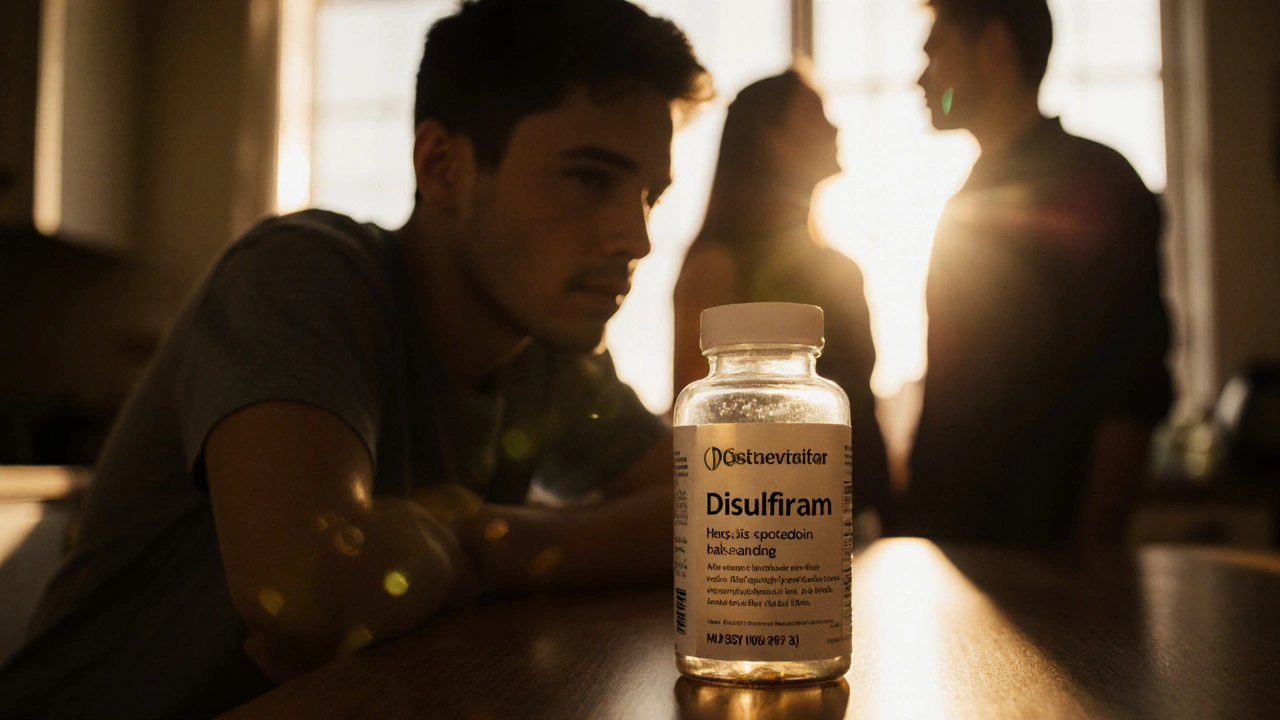Recovery Success Calculator
Recovery Success Calculator
Estimate your recovery success rate based on medication adherence and social support strength.
Your Estimated Recovery Success Rate
The combination of your medication adherence and social support network creates a strong recovery foundation.
Your Results Explained
Recovering from alcohol dependence isn’t just about taking a pill; it’s about surrounding yourself with people who keep you on track. When Disulfiram is combined with a solid support network, the odds of staying sober rise dramatically.
How Disulfiram Works
Disulfiram is a medication that blocks the enzyme acetaldehyde dehydrogenase, causing an unpleasant reaction when alcohol is consumed. The reaction-flushing, nausea, dizziness-acts as a deterrent, making the idea of a drink far less attractive.
The drug is usually prescribed after an initial period of abstinence, often as part of a broader Pharmacotherapy plan that may include counseling or other medicines. In the UK, the NHS supports its use for patients who have demonstrated motivation to stay sober.
The Role of Social Support in Alcohol Recovery
Research consistently shows that people with strong social ties recover faster and relapse less often. A supportive circle supplies accountability, emotional encouragement, and practical help during cravings.
One seminal study from the National Institute on Alcohol Abuse and Alcoholism found that participants with regular peer contact were 30% less likely to relapse within six months. That’s why many clinicians treat social support as a therapeutic ingredient, not just a nice‑to‑have extra.

Combining Disulfiram with a Strong Network
When Disulfiram is paired with consistent social reinforcement, two mechanisms work together:
- Physical deterrence: The drug makes drinking physically unpleasant.
- Psychological reinforcement: Loved ones remind you of your goals, celebrate milestones, and help you navigate high‑risk situations.
Think of it like a safety net: the medication stops you from falling, while the network catches you if you stumble.
Types of Support Networks
Not every support looks the same. Below is a quick rundown of the most common sources of help.
| Support Type | Typical Benefits | How It Helps With Disulfiram |
|---|---|---|
| Family & Friends | Daily encouragement, practical reminders, emotional safety | Reduces temptation at home, reinforces medication adherence |
| Peer Support Groups (e.g., Alcoholics Anonymous) | Shared experience, accountability, coping strategies | Offers a community that understands the disulfiram reaction |
| Professional Counseling (e.g., Cognitive Behavioral Therapy) | Skill‑building, relapse prevention planning, thought restructuring | Teaches ways to manage cravings that might override the medication’s deterrent effect |
| Family Therapy | Improves communication, resolves conflict, aligns goals | Creates a home environment where the disulfiram regimen is respected |
| Online Communities | 24/7 access, anonymity, diverse perspectives | Provides immediate peer reinforcement when cravings strike |

Practical Tips to Build or Strengthen Your Support System
- Tell trusted people early. Let friends and family know you’re on disulfiram and why it matters. Their awareness can prevent accidental exposure to alcohol.
- Schedule regular check‑ins. A weekly phone call or a monthly meet‑up keeps the conversation alive and lets you share progress.
- Join a local group. Manchester hosts several AA meetings and sober‑social clubs. Attending in person adds a face‑to‑face element that virtual forums lack.
- Use a recovery app. Apps that send daily motivational messages or track medication doses act as a digital buddy.
- Set clear boundaries. Ask acquaintances to avoid drinking around you, especially in social settings you’ll attend.
Common Pitfalls and How to Avoid Them
Even with the best intentions, setbacks happen. Recognizing early warning signs can keep a slip from becoming a full relapse.
- Isolating yourself. When cravings rise, people often pull back. Counteract this by planning a “buddy call” ahead of high‑risk events.
- Skipping doses. Missing a day reduces the medication’s deterrent effect. Use pill‑boxes or alarms to stay consistent.
- Relying on one source. If you only lean on family, conflict can jeopardize your plan. Diversify with peer groups and professional therapy.
- Ignoring side‑effects. Some users experience mild headaches or fatigue. Discuss any concerns with your GP; dosage adjustments may be needed.

Checklist for a Successful Recovery Journey
- ✔️ Prescribed Disulfiram by a qualified clinician.
- ✔️ Established a daily medication routine.
- ✔️ Identified at least three reliable support contacts (family, friend, peer group).
- ✔️ Attended a weekly Alcoholics Anonymous meeting or similar.
- ✔️ Completed an introductory Cognitive Behavioral Therapy session.
- ✔️ Created a relapse‑prevention plan that includes “what‑if” scenarios.
- ✔️ Set up a quick‑response system (phone buddy, app alert) for cravings.
- ✔️ Scheduled a follow‑up appointment with the NHS prescriber within 4 weeks.
Frequently Asked Questions
Can I drink alcohol while taking Disulfiram?
No. Even a single drink can trigger severe flushing, nausea, and rapid heartbeat. The reaction is meant to act as a strong deterrent.
How long does Disulfiram stay in the body?
The drug’s half‑life is about 60‑120 hours, meaning it can affect you for up to two weeks after the last dose.
What kind of social support works best with Disulfiram?
A mix of close‑family involvement, regular peer‑group attendance, and professional counseling provides the most comprehensive safety net.
Is Disulfiram safe for people with liver problems?
Caution is advised. The medication is metabolised in the liver, so clinicians often run liver‑function tests before prescribing.
How can I find a support group in Manchester?
The NHS website lists local AA meetings, and community centres often host sober‑social events. A quick call to the Manchester Health and Care Commission can point you to the nearest options.


Tracy O'Keeffe
October 18, 2025 AT 21:02Honestly, the whole “Disulfiram‑plus‑network” hype feels like a glossy PR‑splash, as if a pill could magically sync with your social calendar.
Rajesh Singh
October 30, 2025 AT 16:22While the science is solid, we mustn't forget that true sobriety springs from a moral commitment to oneself; relying solely on friends or a drug can become an excuse for complacency, so personal accountability remains the cornerstone of lasting change.
Linda A
November 11, 2025 AT 11:42The interplay between pharmacology and community support is a classic illustration of dualistic healing. When Disulfiram blocks the enzymatic pathway, it creates a physiological firewall against alcohol. Yet a firewall, no matter how robust, cannot protect a mind that feels abandoned or directionless. In that sense, the social scaffold functions as an emotional compass, steering the individual toward purpose. The literature repeatedly shows that patients with at least three reliable contacts have markedly lower relapse rates. This is not merely a statistical curiosity; it reflects the human need for relational validation. One might argue that medication offers the external pressure while support provides the internal motivation. Such a symbiosis mirrors the ancient yin‑yang balance, where opposing forces generate harmony. Moreover, the ritual of meeting peers weekly can rewire neural pathways associated with craving. Cognitive Behavioral Therapy, when combined with Disulfiram, equips the brain with coping scripts that pre‑empt impulse. A solid family network, on the other hand, can intervene in moments of acute temptation, reminding the patient of their goals. The real power lies not in the pill nor the people alone, but in the intentional choreography of both. Patients who neglect either component often report feeling like they are walking a tightrope without a safety net. Thus, clinicians should assess the robustness of a patient’s support web before prescribing. In practice, a simple checklist-three contacts, weekly meeting, therapy session-can serve as a predictor of success. Ultimately, recovery is a collaborative art, where chemistry and community paint the same hopeful canvas.
Joe Moore
November 23, 2025 AT 07:02Don't be fooled-the pharma giants push Disulfiram as a tidy fix while quietly betting on a sprawling surveillance of our social circles, turning support groups into data farms.
Poornima Ganesan
December 5, 2025 AT 02:22Let me set the record straight: Disulfiram is only a catalyst; without a meticulously curated support network-family, peers, therapists-you’re essentially throwing a match into a windstorm and expecting it to light a controlled blaze of sobriety.